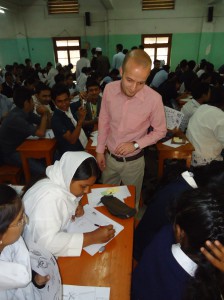
Todd McKay, 2011-2012, Fulbright ETA to Bangladesh, reviews participants’ work at an English speaking and pronunciation workshop in Motijheel, Dhaka, Bangladesh
“Half the battle is applying,” a former linguistics professor of mine once told me. This is the kernel of wisdom—the all-too-true aphorism—that carried me through the Fulbright U.S. Student Program application process. Since that first sit-down with Fulbright’s online application, I have learned a lot and have had ample time to reflect on the application process and on my time in Dhaka, Bangladesh.
I was in the second semester of my MA program in applied linguistics at the University of Utah when thoughts of a Fulbright future first popped into my head. One of the courses in my program was a curriculum design and development course, which included both curricula for foreign language teaching and a professional development component.
“We get so caught up in our academic lives,” my professor said, “that we often forget to work on our professional lives.” She challenged each of us to come up with a practical goal that could be completed by semester’s end.
I decided I wanted to apply for a Fulbright English Teaching Assistant (ETA) grant, but I didn’t think I was qualified. Truth be told, I was downright afraid of applying for a Fulbright grant. I was an okay, but by no means brilliant student. I grew up in a small town 40 miles north of Salt Lake City, Utah, my undergraduate GPA didn’t begin with a 4, and I was not a polyglot studying linguistics under Noam Chomsky.
But, then I remembered, half the battle is applying.
To make the process less daunting, I made it a point to complete one small piece of the Fulbright ETA application each week, whether it be writing a draft of the statement of purpose to show a friend (pro-tip: get as many people as possible to review your essays) or uploading a copy of my unofficial transcript for the online application.
The key to my success was proposing a relevant, feasible, and well thought-out project. It clearly spelled out what I wanted to do when I finally made it to Bangladesh as Fulbright ETA. I considered how this project would be received by the local community of English language teachers and learners. I knew Bangladesh was a poor country with very limited resources. I knew I couldn’t count on having access to whiteboards, multimedia classroom hookups, recording software, high-speed internet access, or other high-tech tools in some regions.
After doing some independent research, I also learned that Bangladesh has made a concerted effort to make English language teaching and learning more interactive since the 1990s. I tailored my project to fit the needs of the Bangladeshi education system by proposing to develop low-resource teaching activities that could be used by Bangladeshi English teachers in both urban (more resources) and rural (fewer resources) communities. Perhaps most importantly, my project was something I could realistically hope to accomplish during my Fulbright grant that also aligned well with Bangladesh’s educational interests and priorities.
Once selected, Fulbright ETAs are provided an in-country affiliation. I was assigned to a high school in Dhaka, Notre Dame College. While teaching there, I sought to develop activities that could be duplicated and reused multiple times requiring few resources and making use of locally available materials. I created a hands-on game to teach about prepositions of location, such as in, at, and on. I used discarded cigarette boxes filled with small items such as a matchstick, a Q-tip, a rubber band, and piece of hard candy and provided a set of instructions to the students telling them how to arrange the items on their desks. This exercise, along with others, helped me appreciate just how hard it can be to teach in Bangladesh, and to consider how to implement strategies that are sustainable from class to class and from teacher to teacher.
While it was hard to create activities for my classes without the use of PowerPoint and other technologies readily available in the U.S., the challenge improved my teaching and will continue to inform how I approach being in the classroom in the future. Understanding what students need and responding to that leads to better teaching and better learning. Better learning, in turn, translates into better test scores and better evaluations, which have bolstered both my credibility as a teacher and the overall reputation of the programs for which I teach. Without my Fulbright ETA experience, I would not be the teacher I am today.
If I could offer only two pieces of advice to potential Fulbright applicants, they would be:
(1) To apply (remember that half the battle is submitting the application).
(2) To carefully consider both how your proposed project will fit with the host country’s interests and whether it can be accomplished within the nine or ten-month Fulbright grant period.
You don’t need to be a savant to be considered for a Fulbright grant, but you do need the courage to apply.



No Comments